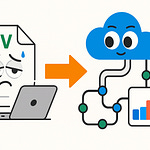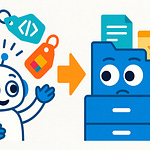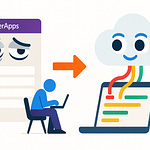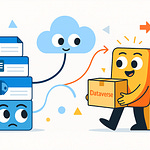What if your software development team had an extra teammate—one who never gets tired, learns faster than anyone you know, and handles the tedious work without complaint? That’s essentially what Agentic AI is shaping up to be. In this video, we’ll first define what Agentic AI actually means, then show how it plays out in real .NET and Azure workflows, and finally explore the impact it can have on your team’s productivity. By the end, you’ll know one small experiment to try in your own .NET pipeline this week.
But before we get to applications and outcomes, we need to look at what really makes Agentic AI different from the autocomplete tools you’ve already seen.
What Makes Agentic AI Different?
So what sets Agentic AI apart is not just that it can generate code, but that it operates more like a system of teammates with distinct abilities. To make sense of this, we can break it down into three key traits: the way each agent holds context and memory, the way multiple agents coordinate like a team, and the difference between simple automation and true adaptive autonomy.
First, let’s look at what makes an individual agent distinct: context, memory, and goal orientation. Traditional autocomplete predicts the next word or line, but it forgets everything else once the prediction is made. An AI agent instead carries an understanding of the broader project. It remembers what has already been tried, knows where code lives, and adjusts its output when something changes. That persistence makes it closer to working with a junior developer—someone who learns over time rather than just guessing what you want in the moment. The key difference here is between predicting and planning. Instead of reacting to each keystroke in isolation, an agent keeps track of goals and adapts as situations evolve.
Next is how multiple agents work together. A big misunderstanding is to think of Agentic AI as a souped‑up script or macro that just automates repetitive tasks. But in real software projects, work is split across different roles: architects, reviewers, testers, operators. Agents can mirror this division, each handling one part of the lifecycle with perfect recall and consistency. Imagine one agent dedicated to system design, proposing architecture patterns and frameworks that fit business goals. Another reviews code changes, spotting issues while staying aware of the entire project’s history. A third could expand test coverage based on user data, generating test cases without you having to request them. Each agent is specialized, but they coordinate like a team—always available, always consistent, and easily scaled depending on workload. Where humans lose energy, context, or focus, agents remain steady and recall details with precision.
The last piece is the distinction between automation and autonomy. Automation has long existed in development: think scripts, CI/CD pipelines, and templates. These are rigid by design. They follow exact instructions, step by step, but they break when conditions shift unexpectedly. Autonomy takes a different approach. AI agents can respond to changes on the fly—adjusting when a dependency version changes, or reconsidering a service choice when cost constraints come into play. Instead of executing predefined paths, they make decisions under dynamic conditions. It’s a shift from static execution to adaptive problem‑solving.
The downstream effect is that these agents go beyond waiting for commands. They can propose solutions before issues arise, highlight risks before they make it into production, and draft plans that save hours of setup work. If today’s GitHub Copilot can fill in snippets, tomorrow’s version acts more like a project contributor—laying out roadmaps, suggesting release strategies, even flagging architectural decisions that may cause trouble down the line. That does not mean every deployment will run without human input, but it can significantly reduce repetitive intervention and give developers more time to focus on the creative, high‑value parts of a project. To clarify an earlier type of phrasing in this space, instead of saying, “What happens when provisioning Azure resources doesn’t need a human in the loop at all?” a more accurate statement would be, “These tools can lower the amount of manual setup needed, while still keeping key guardrails under human control.” The outcome is still transformative, without suggesting that human oversight disappears completely.
The bigger realization is that Agentic AI is not just another plugin that speeds up a task here or there. It begins to function like an actual team member, handling background work so that developers aren’t stuck chasing details that could have been tracked by an always‑on counterpart. The capacity of the whole team gets amplified, because key domains have digital agents working alongside human specialists.
Understanding the theory is important, but what really matters is how this plays out in familiar environments. So here’s the curiosity gap: what actually changes on day one of a new project when agents are active from the start? Next, we’ll look at a concrete scenario inside the .NET ecosystem where those shifts start showing up before you’ve even written your first line of code.
Reimagining the Developer Workflow in .NET
In .NET development, the most visible shift starts with how projects get off the ground. Reimagining the developer workflow here comes down to three tactical advantages: faster architecture scaffolding, project-level critique as you go, and a noticeable drop in setup fatigue.
First is accelerated scaffolding. Instead of opening Visual Studio and staring at an empty solution, an AI agent can propose architecture options that fit your specific use case. Planning a web API with real-time updates? The agent suggests a clean layered design and flags how SignalR naturally fits into the flow. For a finance app, it lines up Entity Framework with strong type safety and Azure Active Directory integration before you’ve created a single folder. What normally takes rounds of discussion or hours of research is condensed into a few tailored starting points. These aren’t final blueprints, though—they’re drafts. Teams should validate each suggestion by running a quick checklist: does authentication meet requirements, is logging wired correctly, are basic test cases in place? That light-touch governance ensures speed doesn’t come at the cost of stability.
The second advantage is ongoing critique. Think of it less as “code completion” and more as an advisor watching for design alignment. If you spin up a repository pattern for data access, the agent flags whether you’re drifting from separation of concerns. Add a new controller, and it proposes matching unit tests or highlights inconsistencies with the rest of the project. Instead of leaving you with boilerplate, it nudges the shape of your system toward maintainable patterns with each commit. For a practical experiment, try enabling Copilot in Visual Studio on a small ASP.NET Core prototype. Then compare how long it takes you to serve the first meaningful request—one endpoint with authentication and data persistence—versus doing everything manually. It’s not a guarantee of time savings, but running the side-by-side exercise in your own environment is often the quickest way to gauge whether these agents make a material impact.
The third advantage is reduced setup and cognitive load. Much of early project work is repetitive: wiring authentication middleware, pulling in NuGet packages, setting up logging with Application Insights, authoring YAML pipelines. An agent can scaffold those pieces immediately, including stub integration tests that know which dependencies are present. That doesn’t remove your control—it shifts where your energy goes. Instead of wrestling with configuration files for a day, you spend that time implementing the business logic that actually matters. The fatigue of setup work drops away, leaving bandwidth for creative design decisions rather than mechanical tasks.
Where this feels different from traditional automation is in flexibility. A project template gives you static defaults; an agent adapts its scaffolding based on your stated business goal. If you’re building a collaboration app, caching strategies like Redis and event-driven design with Azure Service Bus appear in the scaffolded plan. If you shift toward scheduled workloads, background services and queue processing show up instead. That responsiveness separates Agentic AI from simple scripting, offering recommendations that mirror the role of a senior team member helping guide early decisions.
The contrast with today’s use of Copilot is clear. Right now, most developers see it as a way to speed through common syntax or boilerplate—they ask a question, the tool fills in a line. With agent capabilities, the tool starts advising at the system level, offering context-aware alternatives and surfacing trade-offs early in the cycle. The leap is from “generating snippets” to “curating workable designs,” and that changes not just how code gets written but how teams frame the entire solution before they commit to a single direction.
None of this removes the need for human judgment. Agents can suggest frameworks, dependencies, and practices, but verifying them is still on the team. Treat each recommendation as a draft proposal. Accept the pieces that align with your standards, revise the ones that don’t, and capture lessons for the next project iteration. The AI handles the repetitive heavy lift, while team members stay focused on aligning technology choices with strategy.
So far, we’ve looked at how agents reshape the coding experience inside .NET itself. But agent involvement doesn’t end at solution design or project scaffolding. Once the groundwork is in place, the same intelligence begins extending outward—into provisioning, deploying, and managing the infrastructure those applications rely on. That’s where another major transformation is taking shape, and it’s not limited to local developer workflow. It’s about the cloud environment that surrounds it.
Cloud Agents Running Azure on Autopilot
So let’s shift focus to what happens when Azure management itself starts running on autopilot with the help of agents. The original way this discussion is framed often sounds like science fiction—“What happens when provisioning Azure resources doesn’t need a human in the loop at all?” A better way to think about it is this: what happens when routine provisioning and drift detection require less manual intervention because agents manage repeatable tasks under defined guardrails? That shift matters, because it’s not about removing people, it’s about offloading repetitive work while maintaining oversight.
If you’ve ever built out a serious Azure environment, you already know how messy it gets. You’re juggling templates, scripts, and pipeline YAML, while flipping between CLI commands for speed and the portal for exceptions. Every shortcut becomes technical debt waiting to surface—a VM left running out of hours, costs growing without notice, or a storage account exposed when it shouldn’t be. And in cloud operations, even small missteps create outsized headaches: bills that spike, regions that undermine resilience, or compliance gaps you find at the worst possible time.
This is the grind most teams want relief from, and it’s where an agent starts feeling like an autonomous deployment engineer. The idea is simple: you provide business-level objectives—performance requirements, recovery needs, compliance rules, budget tolerances—and the agent translates that intent into infrastructure configurations. Instead of flipping between multiple consoles or stitching IDs by hand, you see IaC templates already aligned to your expressed goals. From there, the same agent keeps watch: running compliance checks, simulating possible misconfigurations, and applying proposed fixes before problems spiral into production.
The difference from existing automation lies in adaptability. A normal CI/CD pipeline treats your YAML definitions as gospel. They work until reality changes—a dependency update, a sudden demand spike, or a new compliance mandate—and then those static instructions either break or push through something that looks valid but doesn’t meet business needs. An agent-driven pipeline behaves differently. It treats those definitions as baselines but updates them when conditions shift. Instead of waiting for a person to scale out a service or adjust regional distribution, it notices load patterns, predicts likely thresholds, and provisions additional capacity ahead of time.
That adaptiveness makes scenarios less error-prone in practice. Picture a .NET app serving traffic mostly in the US. A week later, new users appear in Europe, latency grows—but nobody accounted for another region in the original YAML. Traditional automation ignores it, you only notice after complaints and logs catch up. By contrast, an agent flags the pattern, deploys a European replica, and configures routing through Azure Front Door right away. It doesn’t just deploy and walk away; it constantly aligns resources with intent, almost like a 24/7 operator who never tires.
The real benefit extends beyond scaling. Security and compliance get built into the loop. That might look like the agent observing a storage container unintentionally exposed, then locking it down automatically. Or noticing drift in a VM’s patch baseline and pulling it back into alignment. These are high-frequency, low-visibility tasks that humans usually catch later, and only after effort. By pushing them into the continuous cycle, you don’t remove operators—you free them. Instead of spending energy firefighting, they focus on higher-level planning and strategy.
And that’s an important nuance. Human oversight doesn’t vanish. Your role changes from checking boxes line by line to defining guidelines at the start: which regions are allowed, which costs are acceptable, which compliance standards can’t be breached. A practical step for any team curious to test this is to define policy guardrails early—set cost ceilings, designate approved regions, and add compliance boundaries. The agent then acts as an enforcer, not an unconstrained operator. That’s the governing principle: you remain in control of strategic direction, while the agent executes protective detail at scale.
It also doesn’t mean you throw production into the agent’s hands on day one. If you’re risk-averse, start in a controlled test environment. Expose the agent to a non-critical workload, or select a single service like storage or logging infrastructure, and let it manage drift and provisioning there. This way, you build confidence in how it interprets guardrails before expanding its footprint. Think of it as running a pilot project with well-defined scope and low stakes—exactly how most reliable DevOps practices mature anyway.
At its core, an agentic approach to Azure IaC looks less like writing dozens of static scripts and more like managing a dynamic checklist: generate templates, run pre-deployment checks, monitor for drift, and propose fixes—all under the boundaries you configure. It’s structured enough for trust but flexible enough to evolve when conditions change.
Of course, provisioning and scaling infrastructure is only one side of reliability. The harder issue often comes later: ensuring the code you’re deploying onto that environment actually holds up under real-world conditions. And that’s where the next challenge starts to show itself—the question of catching bugs that humans simply don’t see until they’re already in production.
Autonomous Testing: Bugs That Humans Miss
Tests only cover what humans can think of, and that’s the core limitation. Most production failures come not from what’s anticipated, but from what slips outside human imagination. Autonomous testing agents step into this gap, focusing on edge cases and dynamic conditions that would never make it into a typical test suite.
Consider the scale-time race condition. A .NET application in Azure may perform perfectly under heavy load during a planned stress test. But introduce scaling events—new instances spun up mid-traffic—and suddenly session-handling errors appear. Unless someone designed a test specifically for that overlap, it goes unnoticed. An autonomous agent spots the anomaly, isolates it, and generates a new regression test around the condition. The next time scaling occurs, that safeguard is already present, turning what was a hidden risk into a monitored scenario.
Another example is input mutation. Human testers usually design with safe or predictable data in mind—valid usernames, correct API payloads, or obvious edge cases like empty strings. An agent, by contrast, starts experimenting with variations developers wouldn’t think to cover: oversized requests, odd encodings, slight delays between multi-step calls. In doing so, it can provoke failures that manual test suites would miss entirely. The value isn’t just in speed, but in diversity—agents explore odd corners of input spaces faster than scripted human-authored cases ever could.
What makes this shift different from traditional automation is how the test suite evolves. A regression pack designed by humans stays relatively static—it reflects the knowledge and assumptions of the team at a certain moment in time. Agents turn that into a continuous process. They expand the suite as the system changes, always probing for unconsidered states. Instead of developers painstakingly updating brittle scripts after each iteration, new cases get generated dynamically from real observations of how the system behaves.
Still, there’s an important caveat: not every agent-generated test deserves to live in your permanent suite. Flaky or irrelevant tests can accumulate quickly, wasting time and undermining trust in automation. That’s why governance matters. Teams need a review process—developers or QA engineers should validate each proposed test for stability and business relevance before promoting it into the stable regression pack. Just as with any automation, oversight ensures these tools amplify reliability instead of drowning teams in noise.
Another misconception worth clearing up is the idea that agents “fix” bugs. They don’t rewrite production code or patch flaws on their own. What they do exceptionally well is surface reproducible scenarios with clear diagnostic detail. For a developer, having a set of agent-captured steps makes the difference between hours of guesswork and a quick turnaround. In some cases, agents can suggest a possible fix based on known patterns, but the ultimate decision—and the change—remains in human hands. Seen this way, the division of labor becomes cleaner: machines do the discovery, humans do the judgment and repair.
The business impact here is less firefighting. Teams see fewer late-night tickets, fewer regressions reappearing after releases, and a noticeable drop in time lost on step reproduction. Performance quirks get caught in controlled environments instead of first surfacing in front of end users. Security missteps come to light under internal testing, not after a compliance scan or penetration exercise. That shift opens room for QA to focus on higher-level questions like usability, workflow smoothness, and accessibility—areas no autonomous engine can meaningfully judge.
For practitioners interested in testing the waters, start small. Run an autonomous test agent against a staging or pre-production environment for a defined window. Compare the list of issues it uncovers with your current backlog. Treat the exercise as data collection: are the new findings genuinely useful, do they overlap existing tests, do they reveal blind spots that matter to your business? Framed this way, you’re measuring return on investment, not betting your release quality on an unproven technique.
And when teams do run these kinds of pilots, a pattern emerges: the real long-term benefit isn’t only in catching extra bugs. It’s in how quickly those lessons can be fed back into the broader development cycle. Each anomaly captured, each insight logged, represents knowledge that shouldn’t vanish at the close of a sprint. The question becomes how that intelligence is stored, shared, and carried forward so the same mistakes don’t repeat under different project names.
Closing the Intelligence Loop in DevOps
In DevOps, one of the hardest problems to solve is how quickly knowledge fades between sprints. Issues get logged, postmortems get written, yet when the next project starts, many of those lessons don’t make it back into the workflow. Closing the intelligence loop in DevOps is about stopping that cycle of loss and making sure what teams learn actually improves what comes next.
Agentic AI supports this by plugging into the places where knowledge is already flowing. The first integration point is ingesting logs and telemetry. Instead of requiring engineers to comb through dashboards or archived incidents, agents continuously scan metrics, error rates, and performance traces, connecting anomalies across releases. The second is analyzing pull request history and code reviews. Decisions made in comments often contain context about trade-offs or risks that never make it into documentation. By processing those conversations, agents preserve why something happened—not just what was merged. The third is mapping observed failures to architecture recommendations. If certain caching strategies repeatedly create memory bloat, or if scaling patterns trigger timeouts, those insights are surfaced during planning, before the same mistakes recur in a new system.
Together, these integration points improve institutional memory without promising perfection. The value isn’t that agents flawlessly remember every detail, but that they raise the odds of past lessons reappearing at the right time. Human oversight still matters. Developers should validate the relevance of surfaced insights, and organizations should schedule regular audits of what agents capture to avoid drift or noise creeping into the system. With careful review, the intelligence becomes actionable rather than overwhelming.
Governance is another piece that can’t be skipped. Feeding logs, pull requests, and deployment results into an agent system introduces questions around privacy, retention, and compliance. Not every artifact should live forever, and not all data should be accessible to every role. Before rolling out this kind of memory layer, teams need to define clear data retention limits, set access policies, and make sure sensitive data is scrubbed or masked. Without those boundaries, you risk creating an ungoverned shadow repository of company history that complicates audits rather than supporting them.
For developers, the most noticeable impact comes during project kickoff. Instead of vague recollections of what went wrong last time, insights appear directly in context. Start a new .NET web API and the system might prompt: “Last year, this caching library caused memory leaks under load—consider an alternative.” Or during planning it might flag that specific dependency injection patterns created instability. The reminders are timely, not retroactive, so they shift the focus from reacting to problems toward preventing them. That’s how project intelligence compounds instead of resetting every time a new sprint begins.
It also changes the nature of retrospectives. Traditional retros collect feedback at a snapshot in time and then move on. With agents in the loop, that knowledge doesn’t get shelved—it’s continuously folded back into the development cycle. Logs from this month, scaling anomalies from the last quarter, or performance regressions noted two years ago all inform the recommendations made today. By turning every release into part of a continuous training loop, teams reduce the chance of déjà vu failures appearing again.
Still, results should be measured, not assumed. A simple first step is to integrate the agent with a single telemetry source, like application logs or an APM feed, and run it for two sprints. Then compare: did the agent surface patterns you hadn’t spotted, did those patterns lead to real changes in code or infrastructure, and did release quality measurably improve? If the answer is yes, then expanding to PR history or architectural mapping makes sense. If not, the experiment itself reveals what needs adjustment—whether in data sources, governance, or review processes.
Over time, the payoff is cumulative. By improving institutional memory, release velocity stabilizes, architecture grows more resilient, and engineering energy is less wasted on rediscovering old pitfalls. Knowledge stops slipping through the cracks and instead accumulates as a usable resource teams can trust.
And at that point, the role of Agentic AI looks different. It isn’t just a helper at one stage of development—it starts stitching the entire process together, feeding lessons forward rather than letting them expire. That continuity is what changes DevOps from a set of isolated tasks into a more connected lifecycle, setting the stage for the broader shift now taking place across software teams.
Conclusion
Agentic AI signals a practical shift in development. Concept: it’s not a code assistant but a system that carries memory, context, and goals across the full lifecycle. Application: the clearest entry points for .NET and Azure teams are scaffolding new projects, letting agents handle routine provisioning, and experimenting with automated test generation. Impact: done carefully, this streamlines workflows, reduces setup overhead, and lowers the chance of déjà vu failures repeating across projects.
The best next step is to test it in your own environment. Try enabling Copilot on a small prototype or run an agent against staging, then track one metric—time saved, bugs discovered, or drift prevented. If you’ve got a recurring DevOps challenge that slows your team down, drop it in the comments so others can compare. And if you want more grounded advice on .NET, Azure, and AI adoption, subscribe for future breakdowns. The gains appear small at first but compound with governance, oversight, and steady iteration.











